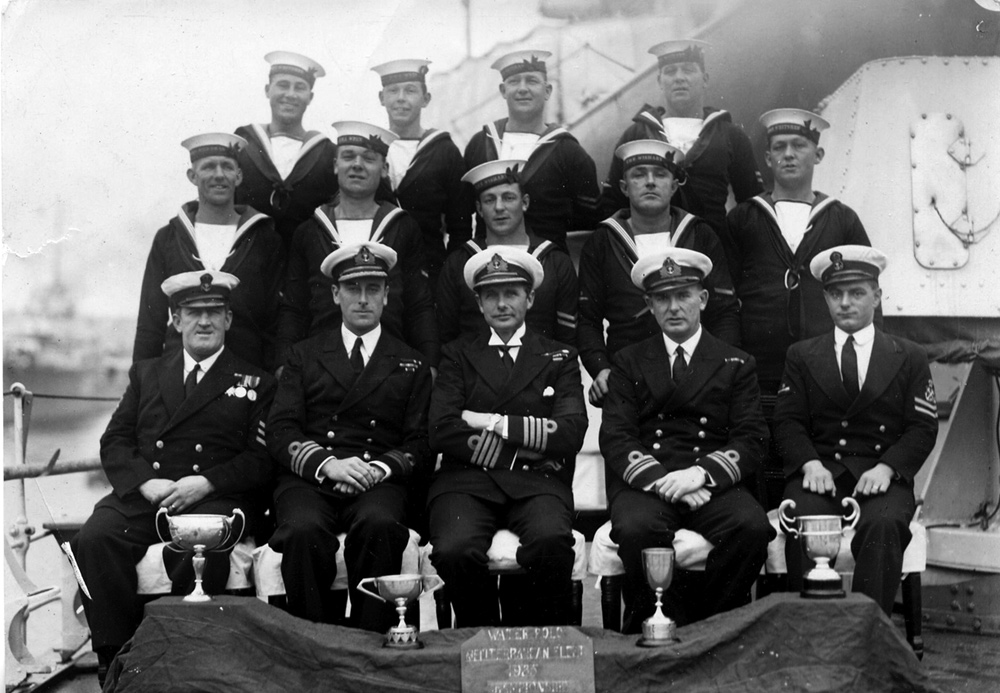
 HMS WISHART
HMS WISHART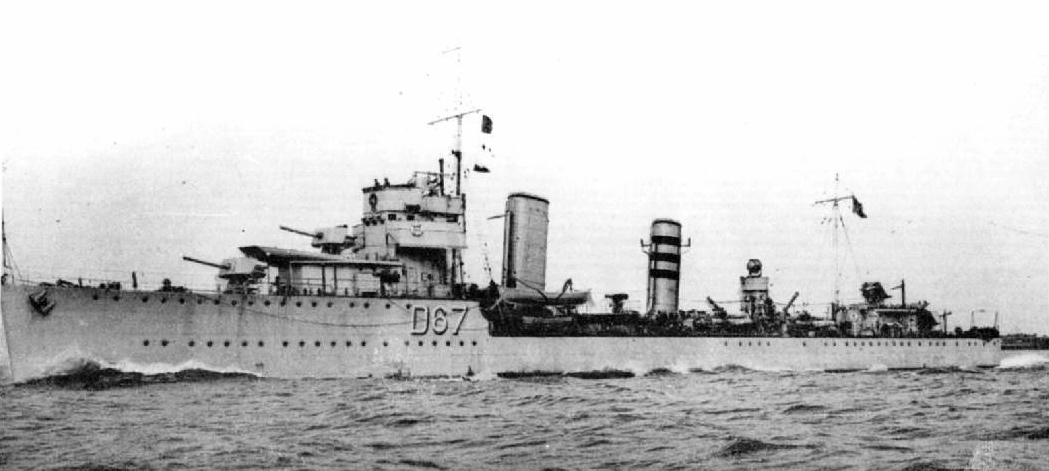
Click on the links within this brief
outline for first hand accounts by the men who served on HMS Wishart and for a more detailed chronolgy see www.naval-history.net
HMS
Wishart (D67) was
a Modified W-Class Destroyer ordered from Thornycroft at Woolston,
Southampton, in January 1918. She was launched on 18th July 1919 and
named after Admiral Sir James Wishart (1659-1723), Captain of the Fleet at the Battle of Vigo Bay in 1702 and MP
for Portsmouth. She was completed in June 1920 and is easily
distinguished from other ships of this type by having two funnels of
almost equal height. During the inter-war years she served in the
Atlantic Fleet and the Mediterranean where she was commanded by Cdr Lord Louis
Mountbatten from 1934-6 (see photograph below).
From
September 1939 she was based at Gibraltar with the 13th Destroyer
Flotilla escorting convoys to Liverpool but in March was transferrred
to Freetown, West Africa, for the local escort of Atlantic Convoys. In
June 1940 she returned to Gibraltar and operated with H Force escorting
carriers flying off aircraft to defend Malta. On 27 June 1941 she sank the
Italian submarine, Glauco west of Gibraltar.
In
July 1941 she returned to Britain for a refit and conversion to a Long
Range Escort (LRE) but because the boiler room arrangements did not
allow an increase in her fuel capacity the conversion did not proceed
and she remained a high speed Short Range Escort (SRE) with enhanced
armament. Cdr. Humphrey Gilbert Scott, RN was appointed CO in September 1941. The photograph of the ship's Company was probably taken at that time. In February 1942 Wishart was adopted by Port Talbot, Glamorgan, after a successful Warships Week National Savings campaign.
After post refit trials she returned to Gibraltar and as part of Force H escorted repeated operations to fly off aircraft to defend Malta. With HMS Wrestler (D35), and aircraft of the Royal Air Force's No. 202 Squadron she sank the German submarine U-74 with all hands east of Cartagena, Spain, in a depth-charge attack on 2 May 1942. In August 1942 she escorted the convoy which broke the blocade of Malta, Operation Pedestal, during which the aircraft carrier, HMS Eagle, was lost.
In November 1942 she escorted convoys to the landing beaches in North Africa, Operation Torch, and was awarded prize money for her help in salvaging the American troopship, Thomas Stone. On 11 December 1942 she rescued survivors from HMS Blean when she was torpedoed by U-443 sixty miles west of Oran. Ten days later she assisted with rescue operations when MV Strathalan was torpedoed on 21 December 1942 with more than 5,000 troops aboard.
Cdr Scott in HMS Wishart
was the Senior Officer of the escort for one of the first through Convoy from
Gib to Alex after the surrender of Axis Forces in North Africa, Convoy
GTX.3, 22 June - 3 July 1943. A week later on 10 July Wishart with Venomous and HMS Witherington escorted the troop ships to the landing beaches at Augusta in Sicily, Operation Husky.
On 24 February 1944 she took part with HMS Anthony
in sinking U-761 which was detected with an airborne Magnetic Anomaly Detector (MAD) by
a Catalina flying boat and its position marked with
smoke bombs. This is believed to be the first time a u-boat was
setected and sunk by this method and the operation was photographed
from the air. Throughout
1944 she remained at Gibraltar escorting convoys in the Western
Mediterranean and in January 1945 was withdrawn from operational use
and returned to Britain, was paid off and reduced to Reserve and then
sold for beaking up at Inverkeithing, near Rosyth.
Commanding Officers
| Lt Cdr Philip John Mack RN (Oct 1923 - Jan 1925) Lr Cdr Sir Irvine Gordon Glennie RN (April 1927 - June 1928) Lt Hugh Merriman Barnes RN (Oct 1928 - April 1930) Cdr Louis Francis Albert Victor Nicholas Mountbatten RN (Dec 1934 - Feb 1936) Cdr. Thomas Leslie Bratt, RN (Feb - Aug 1939) Lt.Cdr. Edward Tyndale Cooper, RN (June 1939 - Sep 1941) |
Cdr. Humphrey Gilbert Scott, RN(Sep
1941 - June
1943)
Cdr. Alan FitzRoy Campbell, OBE, RN (June - July 1943) Lt. Francis Nigel Featherston Johnston, RN (July 1943) Lt. John Arundell Holdsworth, RN (July 1943 - March 1944) Lt. Victor John Manwaring, RN (Mar - mid 1944) |
Officers
This
short list of officers who served on HMS Wishart all
have entries on the unithistories.com web site. Further names from the
Navy List will be added later.
| Lt John Hamilton Allison RN (July 1923 - Jan 1925) Lt Desmond Lisburn Curtis Craig RN (April 1927 - Aug 1929) Lt John Richard ("Dick") Alured Denne RN (May 1939 - April 1940) Lt Ralph Lindsay Fisher RN (Oct 1931 - Sept 1932) Lt Harry John Hall RNR (April - July 1935) Lt Frank Joseph George Hewitt RN (March - October 1938) |
Lt Francis Nigel Featherston Johnston RN (Feb - Dec 1943) Lt Richard George Damyon Keddie RN (Feb 1941 - Feb 1943) Lt Richard William Ravenhill RN (1925) Lt Denys Arthur Rayner RNVR (July 1937 - Feb 1939) Lt Edward Gregson Roper RN (Dec 1934 - Feb 1936) |
Ron Rendle was a torpedoman on HMS Wishart, 1941-3
And was himself torpedoed twice - on HMS Patroclus (1940) and HMS Bickerton (1944)
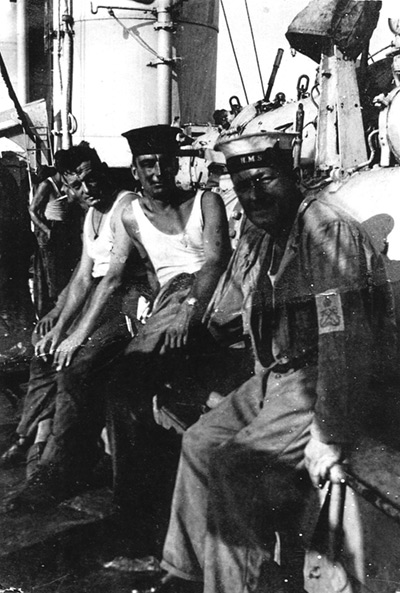 Ronald Walter William
Rendle was born on 31 May 1919 in East Ham but brought up in a suburb of
Ilford and joined Ilford Borough Council's Treasury
Department when he was sixteen. Ron joined the Navy in 1939 and on 26 October was sent to HMS Royal
Arthur, Skegness, for basic training and given the service number P/JX 167874. He was drafted to his first ship,
the Armed Merchant Cruiser (AMC), HMS Patroclus at Portsmouth, on 13 January 1940.
Ronald Walter William
Rendle was born on 31 May 1919 in East Ham but brought up in a suburb of
Ilford and joined Ilford Borough Council's Treasury
Department when he was sixteen. Ron joined the Navy in 1939 and on 26 October was sent to HMS Royal
Arthur, Skegness, for basic training and given the service number P/JX 167874. He was drafted to his first ship,
the Armed Merchant Cruiser (AMC), HMS Patroclus at Portsmouth, on 13 January 1940.
HMS Patroclus patrolled the Atlantic looking for blocade runners. She was escorting the 6,000 ton steamer SS Casanare and HMS Laurentic when they encountered U-99 commanded by Otto Kretschmer on 3 November. Kretschmer sank more allied tonnage than any U-boat commander. The Patroclus was like a floating block of flats with its hull buoyed up by empty oil barrels. U-99 sank all three ships but it took seven torpedoes to sink HMS Patroclus. After the fourth torpedo Ron Rendle jumped into the water, went down, surfaced and was violently sick. He was picked up the next morning by the destroyer HMS Achates, drank some rum, was lent a hammock and slept for twelve hours.
After two weeks survivors leave Ron was drafted to HMS Dunluce Castle, an accommodation ship at Scapa Flow in Orkney. Most of the survors of the Patroclus were
sent there. It was really an opportunity to recover from the trauma of
the sinking. Ron as a clerk in local government was given an office job
and quite liked his three months at Scapa. From 21 May to 20 August
1941 Ron trained to be a torpedo man at HMS St Vincent, a shore establishment in Gosport, Portsmouth.
On 28 September he was drafted to HMS Wishart at Southampton which had just completed a major refit. Wishart returned to its base as part of Force H at Gibraltar. The V & W's were built as "torpedo boat destroyers" (TBD) and
Ron was "on the tubes" but never fired a torpedo, not even in practice.
The six torpedo men
were really electricians; two on the torpedo tubes and four on the depth
charges.The depth charges were rolled off the rails at the stern or thrown from
midships. The three torpedo men
on the left are lounging in front of the triple torpedo tubes on HMS Wishart.
Their new CO, Cdr. Humphrey Gilbert Scott, RN, was "a good
man", a very capable skipper. Wishart "did
every Malta convoy" as part of H Force. If the Padre joined a ship
it was sure to be attacked so Ron was "not pleased to see him" when he joined Wishart
and, sure enough, they were bombed. He saw an ammo ship blown up on one
convoy, looked like "a ball of sun", it just vanished. They towed the USS Thomas Stone into Algiers after she was torpedoed on the 7 November 1942 and
were paid prize money. They went ashore at
Algiers after the landings and "had good
times". He
saw a "bananna boat aircraft
carrier" come out of Algiers with his cousin Clifford on her. He was
killed with most of the crew when she sunk in the Atlantic. Cdr
Scott was keen on hockey and was there to see the ship's hockey team
beat the writers at Gib, the best team on the Rock.
Ron's best friend on Wishartwas AB Arthur Crosby-Clarke who worked for Barclays Bank in Bournemouth before the war and whose regular Watch was "on the Wheel'. Scott liked Ron because he was one of the strongest players in the hockey team and when Wishart docked for repairs at Gib in May 1942 he sent Ron and Crosby-Clark on a short break at the Rest Camp in the Governor's Cottage near the Europa Point light house. Ron served in Wishart until the 13 December 1942 but has no recollection of rescuing survivors from HMS Blean which sank two days earlier. Crosby-Clarke stayed on until Wishart was mothballed in January 1945. They have not met since but Ron still hopes to find out what happened to him.
Ron was relieved at Gib and sent back to Britain to qualify as a Leading Torpedoman at HMS Vernon
which had moved to the former girls school, Rodean, which made him "an
old boy of Rodean". Ron spent the next four months at shore bases for
Coastal Forces: at HMS Attack in Portland from 19 - 25 May, HMS Hornet near the Haslar Gunboat Yard at Portsmouth from 26 May - 14 June and HMS Midge at Great Yarmouth from the 9 August - 14 September 1943. HMS Midge
was one of the major coastal force bases on the East Coast and several
flotillas of MTBs were based there. The details are recorded in his
service record but Ron remembers very little about his time at these
Coastal Forces shore bases.
On
15 September he went to Halifax, Nova Scotia, on a troop carrier and
from there halfway across Canada by train before heading to New York
and Boston where HMS Bickerton, a diesel-electric Captain Class destroyer, was being built. He joined the Bickerton
on 5 November 1943 and remained aboard until she was torpedoed. After
commissioing at Boston she left for Halifax, Nova Scotia, on a
shakedown cruise. They returned to Boston which Ron liked (he had a
girl friend there) and then headed south to Norfolk Virginia which he
did not care for at all. On her way to Britain the Bickerton spent the morning of Christmas Day in Bermuda and then continued to Liverpool. The skipper of the Bickerton "was
very fond of his alcohol" and his "No 1" more or less ran the
ship on the way over. Ron made a mistake testing a circuit on Bickerton due to the wiring on US ships being different and was temporarily blinded and hospitalised at HMS Pegasus, Belfast, from 24 February to 12 March 1944.
Capt G.F.W. Macintyre, RN, a brilliant u-boat hunter on Atlantic convoys, took over as CO of Bickerton and was "the best skipper I ever had". Ron Rendle recalled that the survivors they rescued after sinking U-765 were "much the same as us, they mixed in, had good jokes and got on well with us". Ron had a camera and was able to get film from "an old school pal", Bob Patience, who worked at Selo, part of Ilford. Bob had been the tail gunner on a bombing raid over Hamburg when their plane was badly shot up and the entire crew were invalided out. Ron soon had a good business going, selling film to his friends on Bickerton, taking their photographs, developing the film and making prints. Bickerton patrolled the entrance to the Channel during the D-Day landings and sunk U-269. Ron photographed the frigate HMS Mourne (K 261) blowing up after she was hit by a GNAT torpedo from U-767 on the 15 June 1944. When MacIntyre heard that Ron had a camera he transferred him from his action station with the depth charges at the stern (there were no torpedos on Bickerton) to the Bridge where he would be on hand to photograph the sinking of his next u-boat.
In August Bickerton was sent Scapa Flow to escort two carriers, HMS Nabob and Trumpeter, part of Convoy JW.59, to Tromso in Norway to attack the Tirpitz. On the 22 August 1944 HMS Nabob was hit by an acoustic torpedo, a GNAT, fired by U-354 and soon afterwards Bickerton was hit in the stern and all of Ron's friends at his former action station were killed. Macintyre knew the danger of being hit by a GNAT zeroing in on the acoustic noise of a ship's propellors and had ordered a "cat" to be streamed from the stern. This was a device which vibrated like the screws of a destroyer and lured acoustic torpedoes away from the stern of the ship. They were too late getting it out and the man sent from the bridge to speed things up was killed along with all the me in the depth charge team.
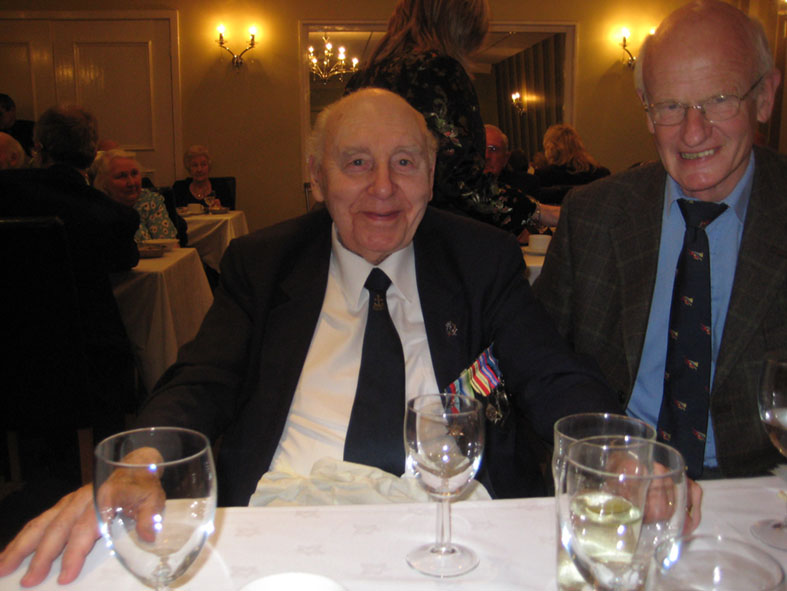 Rescuing survivors from the carrier was
given priority and Macintyre told Ron to stay aboard until a
launch was sent (one did not last long in Arctic waters) by the
Captain Class destroyer, HMS Aylmer. Donald Macintyre described what happened in Chapter 12 of his autobiography, U-Boat Killer
(1956), and Ron Rendle gets a brief mention: "A Leading Seaman Rendle
and an Electrical Artificer Robinson both set good examples, I
remember."
Rescuing survivors from the carrier was
given priority and Macintyre told Ron to stay aboard until a
launch was sent (one did not last long in Arctic waters) by the
Captain Class destroyer, HMS Aylmer. Donald Macintyre described what happened in Chapter 12 of his autobiography, U-Boat Killer
(1956), and Ron Rendle gets a brief mention: "A Leading Seaman Rendle
and an Electrical Artificer Robinson both set good examples, I
remember."
The
money Ron made from his business venture was in the ship's safe and
went down with the ship along with all of Ron's photographs. After
survivor's leave Ron spent almost three months at HMS Victory and HMS Vernon before being drafted to HMS Lanka, the shore base in Ceylon, on 13 December 1944 to await a posting to another ship. HMS Lanka
occupied the site of St Josephs College, Colombo. Ron was given
the job of organising the guard. He never received another posting and
on 2 October 1945 he returned to Britain on the Town Class destroyer, HMS Rotherham.
He really liked the ship's company and they wanted him to stay on. They
had fought in the Pacific war against Japan, been attacked twice by Kamikaze pilots but last minute evasive
action by the CO saved the ship. On 4 September Rotherham was the
first RN warship to enter Singapore after the dropping of the Atom bomb
and the surrender of Japan. The
crew were shocked by the condition of the POWs in the city. Ron returned to England in the Rotherham on 12 November 1945 and was released from the Navy on 31 January 1946 and returned to his prewar career in local government.
He retired as Housing Chief in Kent on a full pension at 55 when local government was reorganised in 1974 and went into business running the Barn nightclub in Braintree with his old friend, Bob Patience. All
the stars of the day played at the Barns and he knew them all. Ron Rendle was 97 in May this year (2016) but visits
the casino once a week and has never missed an annual reunion of the V
& W Destroyer Association. Despite being a keen photographer he has
no photographs of himself in naval uniform. They were all lost when HMS
Bickerton was torpedoed.
Ron Rendle (on left) was photographed with Bill Forster at the reunion of the V & W Destroyer Association at Derby in 2010
Bill recorded an interview with Ron
Rendle at the Reunion of the V & W Association at Warwick on 20
April 2013
Click on the link to listen to Ron describe his wartime service on HMS Wishart
be patient - it takes a couple of
minutes before the file opens and Ron starts speaking
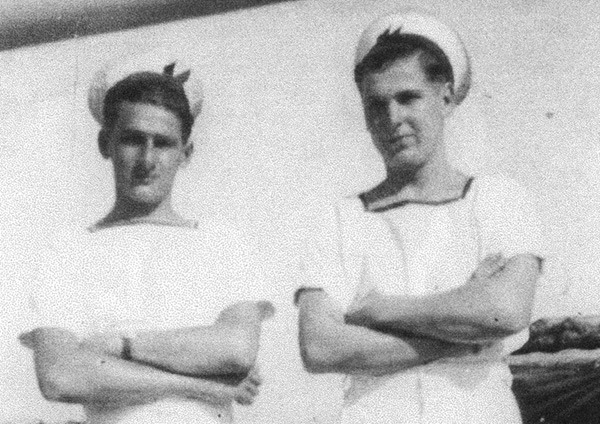 Sixteen young Hostilities Only (HO) ratings joined Wishart in February 1942 while she was based at Gibraltar. They went from Greenock to Gibraltar on the former passenger liner, Llanstephen Castle, which was requisitioned for use as a troop carrier and stayed on the depot ship, Maidstone, until the Wishart
came in. They joined on
the same day, shared the cramped living quarters on the mess decks,
drank together when back in Gib and some are still friends today.
Sixteen young Hostilities Only (HO) ratings joined Wishart in February 1942 while she was based at Gibraltar. They went from Greenock to Gibraltar on the former passenger liner, Llanstephen Castle, which was requisitioned for use as a troop carrier and stayed on the depot ship, Maidstone, until the Wishart
came in. They joined on
the same day, shared the cramped living quarters on the mess decks,
drank together when back in Gib and some are still friends today. 